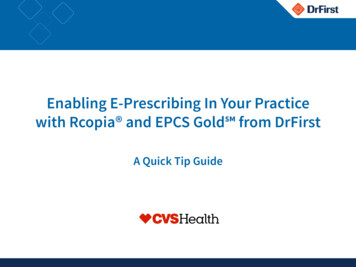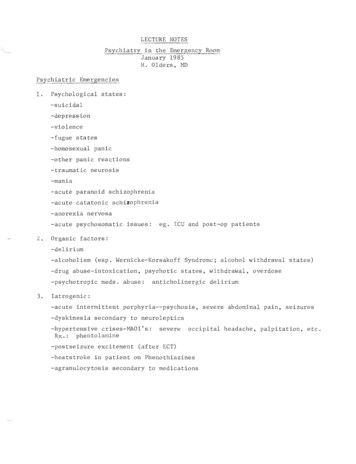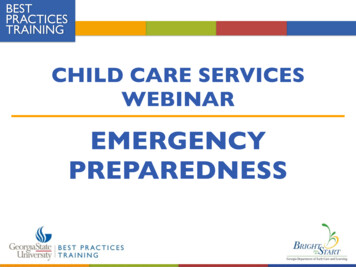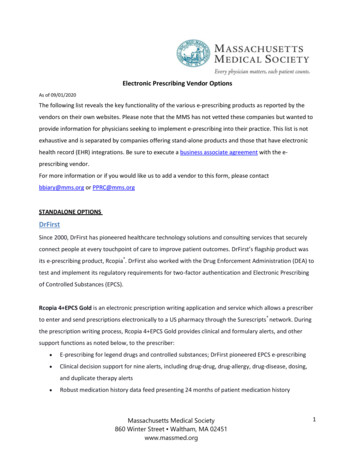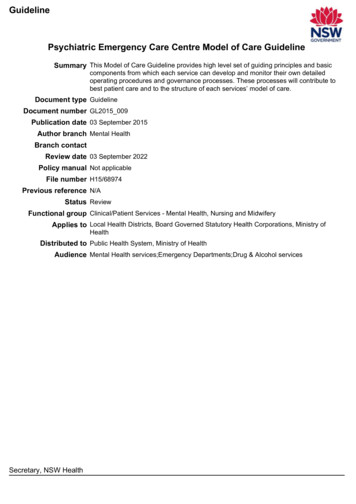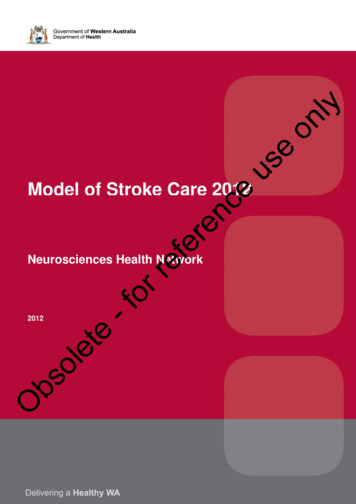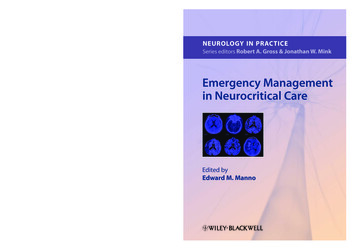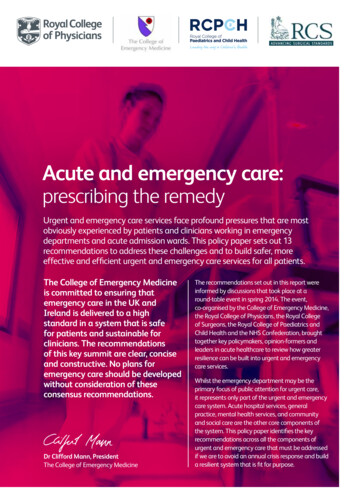
Transcription
Acute and emergency care:prescribing the remedyUrgent and emergency care services face profound pressures that are mostobviously experienced by patients and clinicians working in emergencydepartments and acute admission wards. This policy paper sets out 13recommendations to address these challenges and to build safer, moreeffective and efficient urgent and emergency care services for all patients.The College of Emergency Medicineis committed to ensuring thatemergency care in the UK andIreland is delivered to a highstandard in a system that is safefor patients and sustainable forclinicians. The recommendationsof this key summit are clear, conciseand constructive. No plans foremergency care should be developedwithout consideration of theseconsensus recommendations.Dr Clifford Mann, PresidentThe College of Emergency MedicineThe recommendations set out in this report wereinformed by discussions that took place at around-table event in spring 2014. The event,co-organised by the College of Emergency Medicine,the Royal College of Physicians, the Royal Collegeof Surgeons, the Royal College of Paediatrics andChild Health and the NHS Confederation, broughttogether key policymakers, opinion-formers andleaders in acute healthcare to review how greaterresilience can be built into urgent and emergencycare services.Whilst the emergency department may be theprimary focus of public attention for urgent care,it represents only part of the urgent and emergencycare system. Acute hospital services, generalpractice, mental health services, and communityand social care are the other core components ofthe system. This policy paper identifies the keyrecommendations across all the components ofurgent and emergency care that must be addressedif we are to avoid an annual crisis response and builda resilient system that is fit for purpose.
Acute and emergency care: prescribing the remedyChallenges for urgent andemergency careCurrently the challenges faced by urgent andemergency services overwhelm the capacity ofthe system. In consequence the delivery of qualitycare is compromised. Key contributors to thisphenomenon are rising acuity levels and a lackof accessible and effective alternatives to theemergency department. Further barriers include: complex discharge requirements and communityintegration emergency department crowding and patient flowinto the hospital staff recruitment and retention in acute carespecialties recognising and meeting the needs of specificpatient groups, including frail older people,individuals with mental health conditions,homeless people, adolescents, infants, drug andalcohol users, and patients entering a final illness.Building system resilienceEmergency care must be delivered 24 hours a day,7 days a week, 365 days a year for all patients inneed. System pressures can occur at any time andthe system must be robust enough to withstandsuch pressures without compromising the deliveryof care. The following recommendations must beimplemented to ensure a resilient system that is fitfor purpose.For each recommendation, the main drivers arehighlighted according to whether they operate atlocal or national level. Although a degree of sharedresponsibility invariably exists, this must not be abarrier to action or an excuse for delay.This report is accompanied by a recommendationsstatement specifically referenced to the health andsocial care systems of England, Northern Ireland,Scotland and Wales.Key:L Local recommendationsN National recommendationsAccess and alternativesEvery emergency departmentshould have a co-located primarycare out-of-hours facility.1LThe entire urgent care needs of the population cannotbe delivered within the same framework and resourcesas emergency care. It is not appropriate for accidentand emergency to be regarded as ‘anything andeverything’ or for the emergency department to be‘everyone’s default’.1It is unreasonable to expect patients to determinewhether their symptoms reflect serious illness ormore minor conditions. Co-location enables patientsto be streamed following a triage assessment.This also enables collaborative working includingsharing of diagnostic facilities, reduces duplication ofadministrative tasks and permits patients to be easilyre-triaged should further assessment require so.2Best practice that directs patientsto the right care, first time, shouldbe promoted across the NHS so as to minimiserepetition of assessment, delays to care andunnecessary duplication of effort.3–52 NExamples of best practice include: stroke patients being transferred directly to strokeunits medical patients who have been assessed by a GPbeing taken directly to the medical admissions unit elderly patients with multiple comorbiditiesundergoing investigation by multidisciplinary teams,not necessarily within the setting of the emergencydepartment patients with post-operative complications beingreturned to surgical services patients suffering from falls being assessed first byambulance falls services GP-to-consultant advice lines easy access to urgent clinics.Such best practice must be complemented by agreedand implemented guidelines for the management ofpatients on acute medical and surgical units, mindfulof the need for many such patients to receive crossspecialty care.
Skill mix / case mixIntegration and communitiesAll trainee doctors on acute specialtyprogrammes should rotate though theemergency department.Community and social care mustbe coordinated effectively anddelivered 7 days a week to support urgentand emergency care services.3,11,123 NIn line with recommendations made in Shape ofTraining, Medical Royal Colleges should promote thedevelopment of core common competencies by alldoctors in training.6 Emergency department experience isan invaluable asset.6 This will create a medical workforcewith the interspecialty skills necessary to meet the clinicalchallenges of the future.Senior decision-makers at the front doorof the hospital, and in surgical, medicalor paediatric assessment units, should be normalpractice, not the exception.4This requires investment in the infrastructure ofcommunity care and a change in culture to removemany of the current procedural obstacles. The aimshould be to facilitate the safe discharge and timelytransfer of care of patients from the hospital to their ownhome or usual place of residence. This requires directdaily communication between the hospital and socialcare services, and integrated care planned in advance.LThis is the most reliable way to deliver safe, effectiveand efficient care.7,8 It should include acute physicians,acute paediatricians, GPs, emergency care physicians,geriatricians and psychiatrists. Early senior reviewhas substantial proven benefits, including mortalityreduction, lower admission rates, early safe discharge,reduced lengths of stay and more appropriate use ofinvestigations.Emergency departments should havethe appropriate skill mix and workforceto deliver safe, effective and efficient care.5 NWhere an emergency department does not have onsite back-up from particular specialties, there shouldbe robust networks of care and emergency referralpathways. NHS provider organisations should implementthe recommendations of the Berwick report.9At times of peak activity, the systemmust have the capacity to deploy ormake use of extra senior staff.1067 NLIf escalation procedures are a frequent occurrence, forexample weekly, this is evidence of poor staffing models.Inadequate capacity exacerbates exit block and this inturn increases mortality for all patients.Delivering care to the homeless andto patients with alcohol and substanceabuse problems are exemplar projectsin which best practice models havedelivered proven benefits.Community teams should be physicallyco-located with the emergencydepartment to bridge the gap between the hospitaland primary and social care, and to supportvulnerable patients.8LCo-located teams should include primary carepractitioners, social workers and mental healthprofessionals. The physical, mental and social needsof adults and children with acute or long-term mentalhealth conditions are better met when psychiatric liaisonservices are easily accessible to staff working in theemergency department and acute medical units.13 Bestpractice models for psychiatric liaison services should beadopted across the NHS.Delivering care to the homeless and to patients withalcohol and substance abuse problems are exemplarprojects in which best practice models have deliveredproven benefits.All emergency departments must have timely access to apaediatrician with safeguarding skills and experience.14
Seven-day serviceFunding / fair rewardThe delivery of a seven-day service inthe NHS must ensure that emergencymedicine services are delivered 24/7, with seniordecision makers and full diagnostic supportavailable 24 hours a day, including appropriateaccess to specialist services.11 This will requireadditional resources.The funding and targets systems foremergency department attendancesand acute admissions are unfit for purpose andrequire urgent change.9 NThis will enable equity of outcomes for all patients.Nevertheless, this will require sustainable staff rotasthat encourage recruitment and retention.15 Urgentand emergency care services must also develop andimplement credible plans to meet predictable surgesin demand, such as on bank holidays and when GPservices close. If implemented properly, seven-dayservices can empower hospitals to return patients homesooner, reduce crowding and improve efficiency.Health services are judged on two key components: theability to deliver elective care and the ability to deliverurgent and emergency care. Neither should compromisethe other.Urgent and emergency care servicesmust also develop and implementcredible plans to meet predictablesurges in demand, such as on bankholidays and when GP services close.10 NFunding structures currently penalise all acute careservices and ensure that they are a loss-making activityfor hospitals.1 This condemns the system to be reactive,owing to a poverty of resources. Proactive behavioursare the hallmark of properly managed and sustainablesystems. Though the 4 hour target is useful, it hasinsufficient drivers in place to eliminate exit block andhas perverse effects. Targets must be aligned to supportclinically relevant outcomes and the system reconfiguredto better share ownership of risk and reward, therebyencouraging collaboration and innovation.Delivering 24/7 services requires newcontractual arrangements that enablean equitable work–life balance.11 NFairness and sustainability should underpin all staffcontracts. Current contracts lack the mechanismsnecessary to ensure that acute care specialists have a fairwork–life balance. This issue has been recognised by theSecretary of State, the Department of Health, the NHSConfederation and the British Medical Association.16–18If locum doctors are required to ease workforceshortages, then such locums should be rewarded withlonger fixed-term contracts.Training time is essential for equipping the medicalworkforce with the skills to handle system pressures.Trusts must also support staff suffering from ‘burnout’due to current pressures.‘ There’s no such thingas ‘out-of-hours’ formy condition. I justwant the right care forme, in the right place,at the right time.’Patient representativeKey:L Local recommendationsN National recommendations
Acute and emergency care: prescribing the remedyInformation technology (IT)It is essential that each emergency12 L department and acute admissions unithas an IT infrastructure that effectively integratesclinical and safeguarding information across allparts of the urgent and emergency care system.Proper use of data can allow hospitals and acutecare systems to predict with reasonable accuracytimes of peak pressures using a calendar and systemdashboards. This should inform capacity planningfor medical staffing, bed planning, transport anddiagnostics. The workforce should be able to accessmedical and safeguarding records promptly to ensuresafe and efficient care. The IT infrastructure must alsoallow rapid notification of urgent and emergency careservices to GPs, social care and children’s services.Current data are often of poor quality and certainlycannot be used with confidence to provide an accuratereflection of urgent and emergency care throughoutthe UK.Proper use of data can allowhospitals and acute care systemsto predict with reasonable accuracytimes of peak pressures using acalendar and system dashboards.If configured properly with significantclinical involvement and advice, NHS111, NHS 24, NHS Direct and equivalent telephoneadvice services can help to reduce the pressures onthe urgent and emergency care system.13 NTelehealth staff should be able to access the medicalrecords of patients, such as those found in thesummary care record, and should be supplied withan electronic directory of all healthcare services. Theyshould be able, with senior clinical support, to makeappointments with primary care teams in cases wheresuch a course of action is most clinically appropriate.References1 College of Emergency Medicine, 2013. 10 priorities for emergency for%20Emergency%20Medicine [Accessed 30May 2014].2 NHS England, 2013. The Keogh Urgent and Emergency Care Review – endof stage 1 engagement report. Ph1Report.FV.pdf [Accessed 30 May 2014].3 Royal College of Physicians, 2013. Future hospital case al-case-studies [Accessed 30 May2014].4 Royal College of Surgeons, 2011. Emergency surgery. Standards for unscheduledsurgical care: guidance for providers, commissioners and service planners. ry-standards-for-unscheduledcare [Accessed 30 May 2014].5 British Geriatrics Society, 2010. Acute medical care of elderly people. ind/goodpractice/44-gpgacutecare[Accessed 30 May 2014].6 Shape of Training, 2013. Securing the future of excellent patient care: final reportof the independent review. /Shape of training FINAL Report.pdf 53977887.pdf [Accessed 30May 2014].7 Academy of Medical Royal Colleges, 2012. The benefits of consultant-deliveredcare. nt-delivered-care.html [Accessed 30 May 2014].8 College of Emergency Medicine, 2010. Emergency medicine consultantsworkforce recommendations. .asp?ID 5324 [Accessed 30 May 2014].9 National Advisory Group on the Safety of Patients in England, 2013. A promise tolearn – a commitment to act: improving the safety of patients in England. hment data/file/226703/Berwick Report.pdf [Accessed 30 May 2014].10 College of Emergency Medicine, 2012. Crowding in emergency ode/document.asp?ID 6296 [Accessed30 May 2014].11 Academy of Medical Royal Colleges, 2012. Seven day consultant present care.www.aomrc.org.uk/doc view/9532-seven-day-consultant-present-care [Accessed30 May 2014].12 House of Commons Health Committee, 2013. Urgent and emergency services:second report of session 2013–14. t/cmhealth/171/171.pdf [Accessed 30 May 2014].13 Royal College of Psychiatrists, 2013. Liaison psychiatry for every acute hospital:integrated mental and physical healthcare. www.rcpsych.ac.uk/files/pdfversion/CR183.pdf [Accessed 30 May 2014].14 Royal College of Paediatrics and Child Health, 2014 Safeguarding children andyoung people: roles and competences for health care staff Third Edition. 0%20%20(3).pdf15 College of Emergency Medicine, 2013. The advantages of a flexible, annualisedrota for senior emergency medicine doctors. www.collemergencymed.ac.uk/code/document.asp?ID 7438 [Accessed 30 May 2014].16 House of Commons, 26 November 2013: Column ansrd/cm131126/debtext/131126-0001.htm [Accessed 30 May 2014].17 NHS Confederation, 2013. Emergency care: an accident waiting to cy-care-an-accident-waiting-tohappen [Accessed 30 May 2014].18 Gretton A. Temporary staffing costs at region’s busiest A&E quadruple. EasternDaily Press, 22 April 2014. www.edp24.co.uk/news/health/temporary staffingcosts at region s busiest a e quadruple 1 3566904 [Accessed 30 May2014].
Summary of recommendationsAccess and alternatives1L Every emergency department should have a co-located primary careout-of-hours facility2 N Best practice that directs patients to the right care, first time, should bepromoted across the NHS so as to minimise repetition of assessment,delays to care and unnecessary duplication of effortSkill mix / case mix3 N All trainee doctors on acute specialty programmes should rotate throughthe emergency department4L Senior decision-makers at the front door of the hospital, and in surgical, medicalor paediatric assessment units, should be normal practice, not the exception5 N Emergency departments should have the appropriate skill mix andworkforce to deliver safe, effective and efficient care6L At times of peak activity, the system must have the capacity to deploy ormake use of extra senior staffIntegration7 N Community and social care must be coordinated effectively and deliveredand communities7 days a week to support urgent and emergency care services8L Community teams should be physically co-located with the emergencydepartment to bridge the gap between the hospital and primary andsocial care, and to support vulnerable patientsSeven-day service9 N The delivery of a seven-day service in the NHS must ensure that emergencymedicine services are delivered 24/7, with senior decision makers and fulldiagnostic support available 24 hours a day, including appropriate access tospecialist servicesFunding /10 N The funding and targets systems for emergency department attendancesfair rewardand acute admissions are unfit for purpose and require urgent change11 N Delivering 24/7 services requires new contractual arrangements thatenable an equitable work–life balanceInformation12 L It is essential that each emergency department and acute admissions unittechnology has an IT infrastructure that effectively integrates clinical and safeguardinginformation across all parts of the urgent and emergency care system13 N If configured properly with significant senior clinical involvement and advice,NHS 111, NHS 24, NHS Direct and equivalent telephone advice services canhelp to reduce the pressures on the urgent and emergency care systemKey: L Local recommendations N National recommendations Royal College of Physicianswww.rcplondon.ac.uk Royal College of Paediatrics and Child Healthwww.rcpch.ac.uk The College of Emergency Medicinewww.collemergencymed.ac.uk Royal College of Surgeonswww.rcseng.ac.uk
emergency care should be developed without consideration of these consensus recommendations. Dr Clifford Mann, President The College of Emergency Medicine Acute and emergency care: prescribing the remedy Urgent and emergency care services face profound pressures that are most obviously experienced by pati
